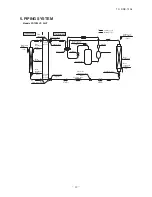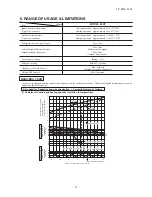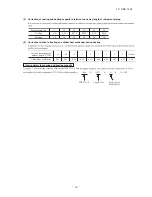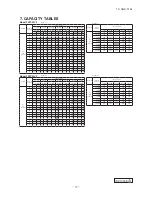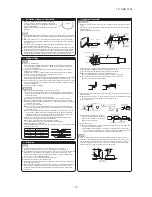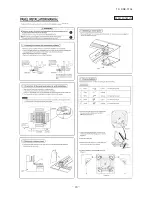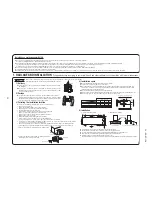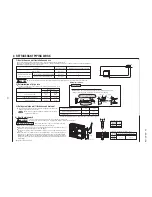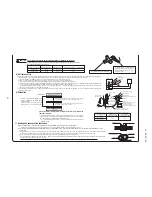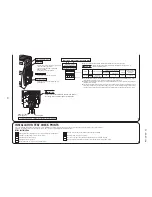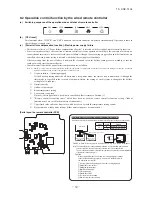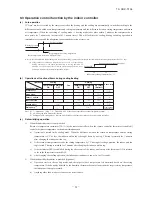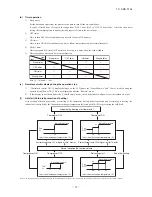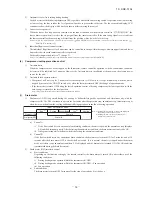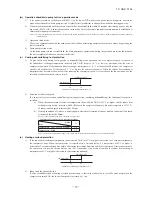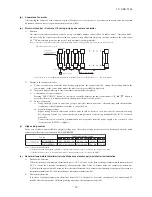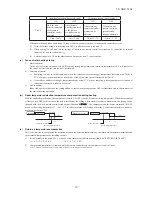
-
26
-
'12 • SRK-T
-126
'09•SRK-DB-087D
Wires for connecting indoor
and outdoor units
Exterior tape
Gas piping
Insulation
Liquid piping
Band (accessory)
Pipe cover (accessory)
7) Heating and condensation prevention
(1) Dress refrigerant pipes (both gas and liquid pipes) for heat insulation and prevention of dew condensation.
●
Improper heat insulation/anti-dew dressing can result in a water leak or dripping causing damage to household effects, etc.
(2) Use a heat insulating material that can withstand 120
℃
or a higher temperature. Poor heat insulating capacity can cause heat insulation problems or cable
deterioration.
●
All gas pipes must be securely heat insulated in order to prevent damage from dripping water that comes from the condensation formed on them during a cooling operation
or personal injury from burns because their surface can reach quite a high temperature due to discharged gas flowing inside during a heating operation.
●
Wrap indoor units’ flare joints with heat insulating parts (pipe cover) for heat insulation (both gas and liquid pipes).
●
Give heat insulation to both gas and liquid side pipes. Bundle a heat insulating material and a pipe tightly together so that no gaps may be left between them and wrap them
together with a connecting cable by a dressing tape.
●
Both gas and liquid pipes need to be dressed with 20 mm or thicker heat insulation materials above the ceiling where relative humidity exceeds 70%.
CAUTION
Do not apply force beyond proper fastening torque in tightening the flare nut.
Fix both liquid and gas operation valves at the valve main bodies as illustrated on the right, and then fasten
them, applying appropriate fastening torque.
Tightening angle (
°
)
Tightening torque (N·m)
Ǿ
6.35 (1/4")
Ǿ
9.52 (3/8")
14
〜
18
34
〜
42
45
〜
60
30
〜
45
150
200
Use a torque wrench. If a torque wrench is
not available, fasten the flare nut manually
first and then tighten it further, using the
left table as a guide.
Recommended length of a tool handle (mm)
Operation valve size (mm)
5) Air tightness test
①
Although outdoor and indoor units themselves have been tested for air tightness at the factory, check the connecting pipes after the installation work for air tightness
from the operation valve’s check joint equipped on the outdoor unit side. While conducting a test, keep the operation valve shut all the time.
a) Raise the pressure to 0.5 MPa, and then stop. Leave it for five minutes to see if the pressure drops.
b) Then raise the pressure to 1.5 MPa, and stop. Leave it for five more minutes to see if the pressure drops.
c) Then raise the pressure to the specified level (4.15 MPa), and record the ambient temperature and the pressure.
d) If no pressure drop is observed with an installation pressurized to the specified level and left for about one day, it is acceptable. When the ambient Temperature fall
1
℃
, the pressure also fall approximately 0.01 MPa. The pressure, if changed, should be compensated for.
e) If a pressure drop is observed in checking e) and a) – d), a leak exists somewhere. Find a leak by applying bubble test liquid to welded parts and flare joints and
repair it. After repair, conduct an air-tightness test again.
②
In conducting an air-tightness test, use nitrogen gas and pressurize the system with nitrogen gas from the gas side. Do not use a medium other than nitrogen gas
under any circumstances.
Gas side
operation valve
Check joint
Press
urize
Clos
e
Outdoor unit
Indoor unit
<
Work flow
>
6) Evacuation
Pay attention to the following points in addition to the above for the R410A and
compatible machines.
○
To prevent a different oil from entering, assign dedicated tools, etc. to each refrigerant
type. Under no circumstances must a gauge manifold and a charge hose in particular
be shared with other refrigerant types (R22, R407C, etc.).
○
Use a counterflow prevention adapter to prevent vacuum pump oil from entering the
refrigerant system.
Airtighteness test completed
Fill refrigerant
Vacuum gauge check
Vacuuming completed
Vacuuming begins
Run the vacuum pump for at least one hour after the vacuum
gauge shows -101kPa or lower. (-755mmHg or lower)
Confirm that the vacuum gauge indicator does not rise even if
the system is left for one hour or more.
When the system has remaining moisture
inside or a leaky point, the vacuum gauge
indicator will rise.
Check the system for a leaky point and
then draw air to create a vacuum again.
Do not hold the valve cap area with a spanner.
(three-way valve)
Charge hose
(Designed specifically for R410A)
Compound pressure gauge
Pressure gauge
Gauge Manifold
(Designed specifically for R410A)
Handle Hi.
Vacuum pump
Vacuum pump adapter
(Anti-reverse flow type)
(Designed specifically for R410A)
Charge hose
(Designed specifically for R410A)
Check joint
-0.1MPa
(-76cmHg)
Handle Lo
Operation Valve
Operation Valve
(two-way valve)
Operation Valve
Cap
Operation Valve
Cap
tightening torque (N·m)
Operation valve cap
tightening torque (N·m)
Check joint blind nut
Ǿ
6.35 (1/4")
Ǿ
9
.52 (3/8")
20
〜
30
10
〜
12
Operation valve size
(mm)
Securely tighten the operation valve cap and the check joint blind nut after adjustment.

